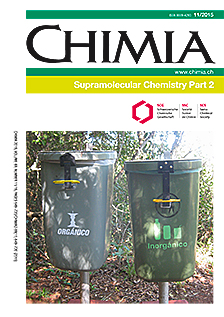Dimension Increase via Hierarchical Hydrogen Bonding from Simple Pincer-like Mononuclear complexes
DOI:
https://doi.org/10.2533/chimia.2015.670Keywords:
Benzimidazolyl ring, Dimension increase, Hierarchical hydrogen bondingAbstract
A tetradentate symmetric ligand bearing both coordination and hydrogen bonding sites, N1,N3-bis(1-(1H-benzimidazol-2-yl)-ethylidene)propane-1,3-diamine (H2bbepd) was utilized to synthesize a series of transition metal complexes, namely [Co(H2bbepd)(H2O)2]·2ClO4 (1), [Cu(H2bbepd)(OTs-)]·OTs- (2),[Cu(bbepd)(CH3OH)] (3), [Cd(H2bbepd)(NO3)2]·CH3OH (4), [Cd(H2bbepd)(CH3OH)Cl]·Cl (5), and [Cd(bbepd)(CH3OH)2] (6). These complexes show similar discrete pincer-like coordination units, possessing different arrangements of hydrogen bonding donor and acceptor sites. With or without the aid of uncoordinated anions and solvent molecules, such mononuclear units have been effectively involved in the construction of hierarchical hydrogen bonding assemblies (successively via level I and level II), leading to discrete binuclear ring (complex 2), one-dimensional chain or ribbon (complexes 3, 4 and 6) and two-dimensional layer (complexes 1 and 5) aggregates.Downloads
Published
2015-11-25
Issue
Section
Scientific Articles
License
Copyright (c) 2015 Swiss Chemical Society

This work is licensed under a Creative Commons Attribution-NonCommercial 4.0 International License.
How to Cite
[1]
S.-R. Zheng, J.-Y. Hou, M. Pan, Ling-Chen, S.-Y. Yin, K. Wu, L.-Y. Zhang, C.-Y. Su, Chimia 2015, 69, 670, DOI: 10.2533/chimia.2015.670.







